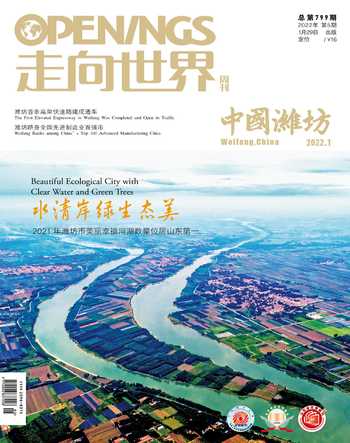独占鳌头的运河传奇
文/一卓

鳌头矶始建于明嘉靖年间,具有极高的艺术价值。图/刁艳杰Built in the Jiajing Period of Ming, Aotouji is of great artistic value.
鳌头矶位于临清市先锋路街道吉士口街,这里是元代运河与明代运河的分岔处,始建于明代嘉靖年间。
“鳌头矶”之名缘于特定的地理环境,鳌头矶以西曾是一处四面环水之地,古称“中洲”。鳌头矶处中洲突出之地,明代正德年间此处叠石为坝,状如鳌头,两支运河上的四处河闸像是鳌的两对足,广济桥在鳌头矶后面像其尾。后因此地风水极佳,始建建筑“弘芸庵”,慢慢成为建筑群。
明代书法家、临清人方元焕为鳌头矶题“独占”二字,意为“独占鳌头”。明代大学士、著名诗人李东阳有诗《过鳌头矶》曰:“十里人家两岸分,层楼高栋入青云。官船贾舶纷纷过,击鼓鸣锣处处闻。”这首诗绘声绘色地描绘出当年临清繁盛的运河风情。不难想见当年高官士贾、文人骚客乘船途经临清,登楼临阁,眺望运河,寄情抒怀、赋诗唱和,是何等惬意。
步入鳌头矶,可见周围楼阁环合。其内有北殿三间,称“甘堂祠”,俗称“李公祠”;南楼三间,名“登瀛楼”,俗称“望河楼”;西殿三间,曰“吕祖堂”;东楼三间,谓“观音阁”。拾级而上望河楼,大运河如同一条玉带在楼前飘过。楼内东西山墙分别悬挂着两块匾额:一块是清康熙年间临清知州、书法家王毂书写的“沙丘古渡”,“沙丘古渡”四字为行书体,苍劲雄浑,神韵丰满,不失为一书法艺术的佳作;一块是清乾隆五十五年(1790年)临清直隶州知州张度书写的“汶卫津梁”,“汶卫津梁”四字为正楷书,端庄而洒脱,颇具功力。
从望河楼转而登上观音阁,极目远望,运河、绿树、街道、行人尽收眼底。正前方是登瀛文化广场,画舫、曲廊、石桥、流水历历在目。观音阁歇山卷棚顶,上覆筒瓦,四角飞挑,木格落地,与望河楼相映成趣,浑然一体,为临清景观“鳌矶凝秀”之所在。
作为一组明代的传统古建筑群,鳌头矶布局严谨,玲珑幽静。院内竹影婆娑,照壁、刻石相映成趣,体现了高超的建筑技艺和不朽的艺术价值。2001年6月,鳌头矶被国务院列为全国重点文物保护单位。
此外,鳌头矶还是一处重要的革命纪念地,亲历了国民革命到抗日战争与解放战争的风风雨雨,曾是党的领导机关所在地和重要活动场所。1936年夏天,一批来自北平的爱国知识分子在鳌头矶成立“山东省第三民教辅导区”,朱启贤任主任,干事有爱国知识分子丁浩川等。第三民教辅导区建立后,逐渐成为以丁浩川为核心的抗日宣传组织,为临清抗日宣传工作作出了重要贡献。1937年卢沟桥事变爆发后,丁浩川、黑若仙、王笔一、秦和珍等共产党员在此创立报社,出版中共临清县工委机关报《力报》,此地便成为传播马列主义、组织群众投身革命的场所。
许多学者、诗人、书画家如季羡林、臧克家、高启云、李予昂、夏雨常等先后为鳌头矶题赠佳作墨宝,国画大师李苦禅81岁时为鳌头矶题写匾额,为古老的建筑增添了新的文化内涵。

明代书法家、临清人方元焕为鳌头矶题“独占”二字,意为“独占鳌头”。图/徐金利Fang Yuanhuan, a calligrapher of Ming and native of Linqing, wrote the inscription “Exclusive” for Aotouji, implying “Heading the List”.
The Grand Canal flows through the actual city of Linqing. Aotouji stands by the old canal, with the inscription of “Exclusive” on the lintel over the gate, looking solemn and magnificent. We may have lost sight of its past prosperity, but cannot help but explore its past when feeling its unique charm of antique beauty. Today, we approached the old building.
Located at Jishikou Street, the Xianfeng Sub-district Office, Linqing, Aotouji is at the fork of the Yuan canal and the Ming canal, built in the Jiajing Period of Ming. Fang Yuanhuan, a calligrapher of Ming and native of Linqing, wrote the inscription “Exclusive” for Aotouji, implying “Heading the List”.
As a traditional building complex of Ming, Aotouji is exquisite and quiet with a rigorous layout. There are bamboo leaves rustling in the wind, as well as screen walls and stone carvings contrasting finely with each other, which demonstrate superb architectural skills and immortal artistic value. In June 2001, Aotouji was listed as a key national heritage conservation unit by the State Council.
Besides, Aotouji is an important revolutionary monument, which has experienced the ups and downs of the National Revolution, the War of Resistance against Japanese Aggression, and the War of Liberation. It was where the Party’s leading body was situated and where important events were organized.
Numerous scholars, poets, calligraphers and painters, e.g. Ji Xianlin, Zang Kejia, Gao Qiyun, Li Yu’ang, and Xia Yuchang, wrote inscriptions, created calligraphy or painting works for Aotouji. Chinese painting master Li Kuchan even wrote an inscription for Aotouji when he was 81. Now, Aotouji has become the seat of the Linqing Museum, and added a new cultural connotation to this old building.

